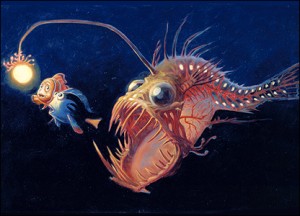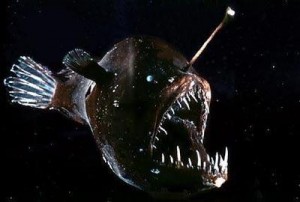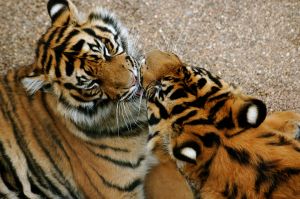To all avid anglers: Ever loved fishing so much you just want your life to revolve around it?
Well, here’s an idea. The deep sea anglerfish , Melanocetus johnsoni, literally does that by having the rod, line and bait all integrated into its body. Going where no other line or bait can ever reach, this angler dwells in the lonely, lightless bottom of the world’s oceans, at a depth of a few thousand feet. The deep sea anglerfish is one of the 200 over species of anglerfish that can be found in the world, all of which possess this angling skill unique to their kind only.
These bony fishes are named for their characteristic mode of predation, where they use an elongated dorsal spine sprouting from the middle of their head over their eyes as a rod and line, and the fleshy growth at the tip of this spine as bait to lure prey in. Such an action resembles angling, hence their name. The deep sea anglerfish typically have at least one of these long filament spines; these are the spines from the anterior dorsal fin. In most anglerfish species, the longest filament is the first (the illicium), and that is where the fleshy growth (also called the esca) used to bait prey can be found. This illicium can be moved around in all directions, and the deep sea anglerfish cleverly manipulates this movement in such a way that the esca resembles a worm (or any other prey animals). Their jaws, which can be extended up to twice their body size, are then triggered to react upon a prey contacting their esca. In this way, their next meal is lured close to their mouths, and devoured whole in a swift action.
Here is a videoclip depicting how the anglerfish “fishes” for its prey.
In the near-lightless conditions at the bottom of the ocean, the deep sea anglerfish emits light from its esca to attract and lure prey. This light is blueish green, and is produced through a chemical process known as bioluminescence by bacteria housed in the esca. In some species of anglerfish, their organs or other parts of their bodies emit light as well through the same process.
At this point, i guess i would have to burst the bubble of all avid male anglers by saying that the best anglers of the year goes to the females, in the context of the deep sea anglerfish. Across all anglerfish, this distinctive dorsal spine or illicium, and esca, are features that belong only to the females. The males do not have them. The male anglerfish is significantly smaller than the female, and completely different in appearance.
What is interesting to note is that when a male anglerfish matures, its digestive system degenerates and it cannot feed on its own anymore. Therefore it has to find a female or die of starvation. The male angler uses its small hooked teeth to latch itself onto a female, at the same time releasing an enzyme that dissolves the skin of his mouth and that of her body. The two become fused together and their blood vessels join as one. The male, now inseparable from the female, acts as a parasite and gets all of his nourishment from her body. A female can as many as six males on her body. Such a behaviour ensures that when it is time for the female to spawn, she has a mate by her side made readily.
The features and characteristics of the deep sea anglerfish certainly makes this angler both weird and unique. Their well developed angling techniques and efficient natural angling equipment has enabled them to stand out as outstanding anglers. At the same time, their grotesque appearance and scary features have earned them the nickname “common black devil”.
Well, one thing is for sure. I wouldn’t want it as a nightlight!
References
“Anglerfish”. Wikipedia, the free encyclopedia. URL: http://en.wikipedia.org/wiki/Anglerfish (Accessed on 08 April 2010)
“Anglerfish Lophius Piscatorius”. National Geographic. URL: http://animals.nationalgeographic.com/animals/fish/anglerfish.html (Accessed on 08 April 2010)
“Anglerfish”. Hosted on The Aquarium Project. URL: http://web.ukonline.co.uk/aquarium/pages/anglerfish.html (Accessed on 08 April 2010)
“Animal fact files, Angler fish(Deep Sea)”. BBC, August 2005. URL: http://www.bbc.co.uk/nature/blueplanet/factfiles/fish/angler_fish_bg.shtml (Accessed on 08 April 2010)
“Creatures of the deep sea”. Hosted on Sea and Sky. URL: http://www.seasky.org/deep-sea/anglerfish.html (Accessed on 08 April 2010)
“Anglerfish, Finding Nemo – Copyright Pixar,” by Randy Berrett. BBC News Online. URL:http://news.bbc.co.uk/nolpda/ifs_news/hi/newsid_4527000/4527948.stm (Accessed on 08 April 2010)
“The sexual peculiarities of the angler fish”. Scribal Terror, 17 Jun 2007 . URL: http://scribalterror.blogs.com/scribal_terror/2007/06/the_sexual_pecu.html (Accessed on 08 April 2010)
“Looking like something out of a science fiction movie, the anglerfish uses a natural lure to draw its next meal nearer,” by Bruce Robison/Corbis. National Geographic. URL: http://animals.nationalgeographic.com/animals/fish/anglerfish.html (Accessed on 08 April 2010)
“Deep Sea Anglerfish Male,” by David Shale. Allposters.com. URL: http://www.allposters.com/-sp/Deep-Sea-Anglerfish-Male-Posters_i2634465_.htm (Accessed on 08 April 2010)
“Deep-Sea Anglerfish – Big Mom, Tiny Dad”. Oceanservice. URL: http://oceanservice.noaa.gov/education/yos/multimedia/podcast.html (Accessed on 08 April 2010)
“Animalclips, Anglerfish-Fauna Clips”. YouTube, 02 Jul 2008. URL: http://www.youtube.com/watch?v=EqJzuc9pE00(Accessed on 08 April 2010)









